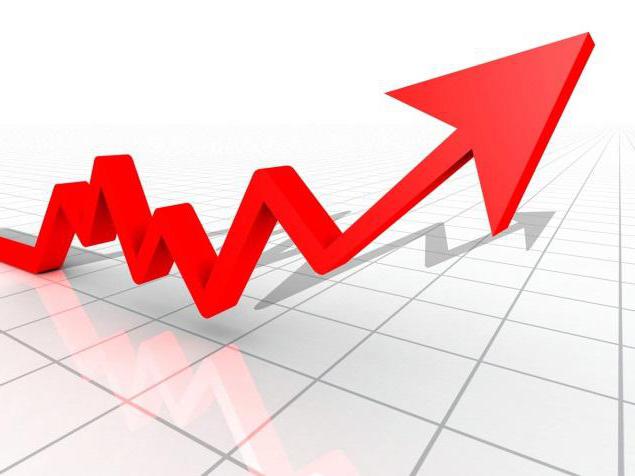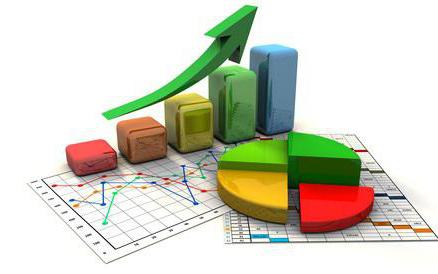The economic profit of production is of interest not only to investors and directors, but also to ordinary workers. After all, their wages depend on her. But to calculate the profit from the sale of goods, how much you need to invest, how the value of assets changes, is not entirely simple. Demand, price, and the number of sales are constantly changing on the bridgehead of the economic market, so it is important to monitor production profitability indicators and analyze them.
What does the word "profitability" mean in the economy?
The efficiency of production can be seen by calculating the profit that the company received from the sale of its products. The capital remaining after covering the costs of producing the goods is called profitability. In other words, it is an effective use of the organization’s funds, in the process of which it makes a profit.

Profitability in the economy is absolute and relative indicators which can be expressed in rubles or percent. Different types of profitability in the enterprise are calculated using certain formulas.
Economic profitability indicator
This concept is designated in science as profitability, profitability and utility, characterizes economic efficiency and is relative. It comprehensively reflects the fruitful use of the resources of an enterprise.
Reserves are considered material, labor, monetary and other objects. The coefficient, which shows what is the economic profitability of the enterprise, is calculated on the basis of the ratio of profit to assets. This indicator is important in the statistical report on the operation of the facility.
When conducting a comparative and financial analysis of the enterprise, the indicator of economic profitability is calculated without fail. For a market economy, there is a system of indices (indicators) of profitability (profitability), which can be calculated both as a whole and by individual types. The level and dynamics of the indicator are the main objects of attention of managers of organizations, since profitability reflects the achieved balance of internal and external economic interests. The following groups of profitability indicators are distinguished: return on investment, production assets and sales.
Return on assets
It is important for any company manager or its investor to know what profit he has. All types of income from the activities of the enterprise are calculated differently.

For each type of profitability, there is a way to determine the necessary values. The formula for calculating the return on assets is as follows:
R (assets) = P (net, for a certain period) / Amount of assets (total, for the same period).
Calculations show how the economic return on assets is able to generate profit for the enterprise. This is a kind of indicator, cleared of borrowed funds, which shows what is the profitability and effectiveness of the organization.
Profit of production assets
The economic profitability of the enterprise in relation to the group of production assets (PF) is calculated by the following formula:
R (PF) = Retained earnings / Average value (Price of fixed assets + intangible assets + current assets (commodity and material).
PF profitability is higher, the higher the profitability.
The PF indicator shows the values of what is currently the economic profitability. Its formula is as follows:
R (PF) = P / PF (average annual cost).

If we divide the profit from sales for the year by the average cost of fixed assets (fixed assets) and MPF (material production assets), then we get the profit indicator of production assets. In this case, the economic profitability of the PF indicates the effectiveness of their use. The specific meaning of the numerical values is the amount of profit attributable to each monetary unit of the value of this part of the assets. The larger this value, the more efficiently the company's resources are used. Production assets are divided into fixed and current assets. In relation to each group, it is possible to calculate the economic profitability using an identical technique. To make the calculations accurate, take the average indicators for the period.
The profitability of production assets must not only be determined, but also analyzed. Methods of analysis are similar to other indicators of profitability. It is enough to analyze the dynamics of the indicator for several periods - it is called horizontal. After that, you should compare the values with industry average or with the levels of similar enterprises. You can resort to factor analysis, which allows you to determine the causes of changes. If divided gross margin at the cost of production, we get R production. R cost is also called the profitability of production. This is due to the fact that the economic profitability of the organization at cost indicates the effectiveness of the enterprise as a whole.
Sales profitability

The economic profitability of sales indicates the share of profit in each currency unit earned. Calculation of sales profitability is as follows:
R (sales) = Profit (net) / Revenue
Profitability of sales is an indicator of the company's pricing policy, an indicator of the ability to control costs, the amount of profit from the sale of goods in each currency unit of revenue without interest and tax costs.
Return on sales characterizes many factors. To the above, for example, refers to the indicator of the share of profit in the structure of revenue from sales. It is called the rate of profitability.
If the profitability of sales decreases, then the competitiveness of products in the market decreases, which, in turn, indicates a decrease in demand. In this case, specific measures are required to prevent the non-profit operation of the enterprise. To achieve increased profitability of sales, they increase the prices of products sold, as well as reduce its cost. You can increase profits from the goods sold by increasing the proportion of more profitable types of products.
To increase the profit from the sale of the organization, it is necessary to control any changes in the market, monitor the dynamics of the pricing policy for similar products, the level of costs for production needs and product sales, and work on the assortment.
Return on current assets
 Negotiable are current assets that can change every moment. If you take into account the features of accounting, it is often difficult to separate current assets (OA) for the main and non-core activities. There is an opinion that it is more advisable to calculate the return on total mobile assets. In this case, take into account the total profit (loss) before taxes. Then:
Negotiable are current assets that can change every moment. If you take into account the features of accounting, it is often difficult to separate current assets (OA) for the main and non-core activities. There is an opinion that it is more advisable to calculate the return on total mobile assets. In this case, take into account the total profit (loss) before taxes. Then:
R (OA) commonly. = (Profit (sales + other) / total OA) * 100%.
If you paint this formula in expanded form, which takes into account the costs of production costs, costs of commerce and management, we get:
R (OA) commonly. = ((Sales revenue - (Production costs + commercial expenses + management expenses) + Incomes (other) - Costs (other)) / total OA) * 100%.
If we take into account the division of costs, then the OA profitability formula will be as follows:
R (OA) commonly. = ((Sales revenue - (Fixed costs + Variable costs) + Revenues (non-core) - Costs (other) / total OA) * 100%.
Return on investment
Return on investment shows the effectiveness of the use of funds invested in the development of this enterprise. She also has her own formula and is calculated as follows:
R (in) = ((Investment return - Investment price) / Investment value) * 100%.
Another profitability ratio is calculated:
R (in) = ((P + (C (sales) + C (acquisitions))) / Acquisition price) * 100%, where
P - profit;
C is the price.
Economic return on equity

Return on equity (hereinafter referred to as SK) indicates the income from invested finance by the owners of the enterprise. The economic return on equity is calculated by the formula:
R (SK) = P (in the use of the organization) * 100% / size of SK
The result of a comparison of the utility of assets and equity will be conclusions about the degree of use of borrowed funds, which are financial leverage for the company. Such an analysis is necessary to increase the level of profitability.
R equity will be higher if the weight (specific) of credit in the total amount of sources of formation of assets increases. The difference between the profitability of the UK and the profitability of the total amount of capital is called the effect of financial leverage.
Shoulder financial leverage shows the proportion of the share of borrowed funds in the total amount of financial sources of formation of property of the enterprise.
The optimal ratio of sources of formation of the assets of the enterprise will be considered when it provides the maximum increase in return on equity in combination with an acceptable amount of financial risk.
Profit of products or production activities
 The profitability of products for the enterprise is important to calculate, since it makes it possible to determine the difference between the cost of its production and revenue for it. This indicator can be calculated by the formula:
The profitability of products for the enterprise is important to calculate, since it makes it possible to determine the difference between the cost of its production and revenue for it. This indicator can be calculated by the formula:
The profit that remained at the disposal of the enterprise, multiplied by 100%, and divided by the total cost of sales.
Also, before dividing by cost, you can use the value of profit from the sale of products. This formula shows well what income the company received from each ruble invested in the production and sale of goods. Product profitability can be calculated within the entire organization, as well as its structural components.
Economic return on joint investment
This indicator is a general indicator for the funds of the entire enterprise. It expresses how effectively they are used. Based on this value, it is possible to draw conclusions about the entire work of the organization, to analyze the economic profitability and then take measures to increase profitability or continue the same work.
Like everyone else, the return on total capital investment is calculated according to its formula:
Expenses incurred in the course of loans + Profit, which the company currently has * at 100% / Value of joint capital (also called balance sheet currency).
Formula for Economic Profitability
Economic profitability, the formula of which is universal, is calculated simply:
R = (P (net or from sales) / Indicator, for R calculated) * 100%.
The indicator in the denominator always has a value expression. For example, for sales, this is revenue, which, in turn, is calculated as follows:
Price * sales = revenue.








